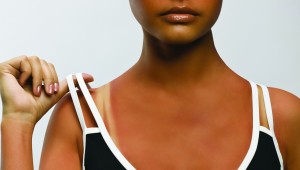
A sunburn is an injury to the skin due to UV radiation from the sun. UV light is a combination of different types of radiation. There are two types of UV radiation most responsible for sunburn. UVA rays cause aging. This is invisible damage, and after many years of sun exposure, is difficult to reverse and builds up over time. UVB rays cause burning—or sunburn. This is a visible injury and damage you can see after a few hours. It is important to understand the potential effects of UV light and how sunburns occur.
Melanin is the pigment in the outer layer of skin that gives your skin its normal color. When skin is exposed to sunlight, your body tries to protect itself by speeding up the production of melanin. This extra melanin is what creates a tan. A suntan is your body’s way of blocking the UV rays to prevent sunburn and other skin damage. But the protection only goes so far. The amount of melanin you produce is determined genetically. Many people simply don’t produce enough melanin to protect the skin well. Eventually, UV light causes the skin to burn, bringing pain, redness and swelling.
Although it may seem like a temporary condition, sunburn—a result of skin receiving too much exposure from the sun’s ultraviolet (UV) rays—can cause long-lasting damage to the skin. According to the Skin Cancer Foundation, people double their risk of melanoma if they have had five or more sunburns.
Without proper protection from clothing and sunscreen, your skin can burn. To help calm stinging skin, you should treat the sunburn as soon as you notice it. The first thing you need to do is get out of the sun. Here are some tips to help alleviate the discomfort of a sunburn:
1. Drink extra water. A sunburn will draw fluid to the surface of the skin and away from the rest of the body. Drinking more water when you are sunburned helps to avoid dehydration.
2. Should blisters form, allow the blisters to heal. Blistering skin means you have a second-degree sunburn. Do not pop the blisters, as blisters form to protect you from infection and to help your skin heal.
3. Take frequent cool baths or showers to help relieve the pain. Gently pat yourself dry, but keep your skin slightly damp. Then, apply a moisturizer to help trap the water in your skin.
4. Apply a moisturizer that contains aloe vera to help soothe sunburned skin. If an area feels especially uncomfortable, you can apply a hydrocortisone cream that you can buy without a prescription. Do not treat sunburn with “-caine” products (such as benzocaine), because these may irritate the skin.
5. Consider taking ibuprofen or aspirin to help decrease any swelling, redness and soreness.
What’s the harm in sunburn?
Sunscreen can protect your skin against sunburn, skin cancer, and premature aging. However, it is not as effective unless it’s applied correctly. Choose sunscreen that has an SPF of 30 or higher, is water resistant, and provides broad-spectrum coverage, which means it protects you from UVA and UVB rays.
1. Apply sunscreen generously before going outdoors—even on cloudy days. It takes about 15 minutes for your skin to absorb the sunscreen and protect you. If you wait until you are in the sun to apply sunscreen, your skin is not protected and can burn. And don’t forget to apply sunscreen on cloudy days. As much as 80 percent of UV rays pass through clouds.
2. Use enough sunscreen. Most adults need at least one ounce of sunscreen, about the amount you can hold in your palm, to fully cover all exposed areas of your body. Rub the sunscreen thoroughly into your skin.
3. Apply sunscreen to all bare skin. Remember your ears, face, neck, tops of your feet and legs. For those hard-to-reach areas like your back, ask for someone to help you or use a spray sunscreen. If you have thinning hair, either apply sunscreen to your scalp or wear a wide-brimmed hat. Re-apply sunscreen at least every two hours to remain protected, or immediately after swimming or excessively sweating.
This spring and summer, seek the shade, especially between 10 A.M. and 4:00 P.M., avoid tanning and tanning booths, use sunscreen with an SPF of 30+ daily, and wear a hat and UV blocking sunglasses. Remember to examine your skin from head to toe every month and see your dermatologist every year for a professional skin exam.
Sources:
Excellence in Dermatology™ Excellence in Dermatologic Surgery™ Excellence in Medical Dermatology™ Excellence in Dermatopathology™. (2015, May 19). Retrieved June 2, 2015, from https://www.aad.org/stories-and-news/news-releases/study-most-americans-don-t-use-sunscreen
Skin Cancer Foundation. (n.d.). Retrieved June 2, 2015, from http://www.skincancer.org/prevention/sunburn/facts-about-sunburn-and-skin-cancer
 Central Florida Health and Wellness Magazine Health and Wellness Articles of the Villages
Central Florida Health and Wellness Magazine Health and Wellness Articles of the Villages


